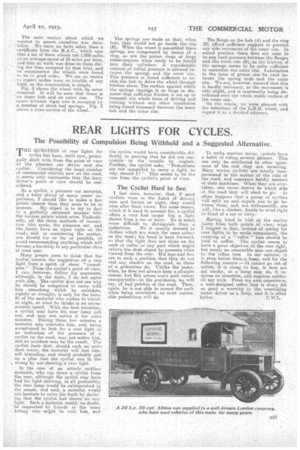REAR LIGHTS FOR CYCLES.
Page 13

If you've noticed an error in this article please click here to report it so we can fix it.
The Possibility of Compulsion Being Withheld and a Suggested Alternative.
THE QUESTION of rear lights for cycles has been, until now, principally dealt with front the point of view of the pleasure car driver and the cyclist. Considering the large number , of commercial vehicles now on the road, it sieems -only reasonable that the lorry driver's point of view should be considered.
As a cyclist, a pleasure car motorist, and a lorry driver of many years' experience, I should like to make a few points clearer than they seem to be at present, My object is to try to deal in• a perfectly unbiased manner with the various points which arise. IThdouhtedly, all the three methods of locomotion (the cycle, the pleasure ear, and the lorry) have an equal right on the road; and in considering the matter, one should try so far as possible, to avoid recommending anything which will hetioine a hardship to any particular class of road user.
Many people seem to think that the cyclist resents the suggestion of a rear light from a spirit of sheer " cussedness." From the cyclist's point of view, I can, however, follow his argument, although, in the main, I do not ,agree with him. The cyclist does net see why he should be compelled to carry with him something which he considers, rightly or wrongly, is only or the benefit of the motorist who wishes to travel, at night, at what he thinks is an-unreasonable speed. With the best intention, a cyclist may have his rear lamp . jolt out, and may not notice it for some minutes. During those few minutes a motorist may overtake him, and, being accustomed to look for a rear light as an indication of the presence of a cyclist on the road, may not notice him, and an accident may be the result. The cyclist feels that, should such an accident occur, . the motorist will feel himself blameless, and would probably put up a plea that the cyclist was in the wrong by not showing a rear light.
In the case of an utterly reckless Motorist, who ran down a cyclist from the rear, although the cyclist may have had his light showing, in all probability the rear lamp would be extinguished in the -smash, and such a motorist would not hesitate to cover his fault by declaring that the cyclist had shown no reile light. Such a motorist would; no doubt, be supported by friends of the same. kidney who might be with him, and
the cyclist would have considerable difficulty in proving that he did not, contribute to thetrouble by neglect. Further, the cyclist asks, " Pedestrians are not compelled to carry a light, so why should I?" This seems to be tl.e case from the cyclist's point of view.
The Cyclist Hard to See.
I feel sure, however, that, if mo3t cyclists were in the habit of driving cars and lorries at night; they would soon alter their views. For some reason, which it is hard to account for, a cyclist offers a very bad target for. a light shown from a car or lorry. He is much more difficult to distinguishthan a pedestrian. He is usually dressed in clothes which are much the same colour as the road; his bead is bent forward, as that the light does not shine on his neck or collar or any .part which might relieve the drab object he presents when viewed from the rear. His leas and feet, are in such a position that they do not cast any shadow on the road, as those of a pedestrian do. Unlike the pedestrian, he does not always keep a straight course, but flits across one's path rather unexpectedly—in the avoidance we will say, of bad patches of the road. Then, again, he is not able to mount the path when being overtaken, as most reasonable pedestrians will do. To make matters worse, cyclists have a habit of riding several abreast. This can only be attributed to utter ignorance of the risk they are incurring. Many novice cyclists are totally inexperienced' in the matter of the rule of the road, and somecare hardly masters of their machines. When they are overtaken, one never knows to which side.
of the road they will elect to go. It often happens that a group of cyclists will split up and' exited you to go between them, and, not infrequently, one will, like a chicken, decide to cross right in front of a car or lorry. '
Having tried to idok . at the matter fairly from both points of view' what I suggest is that, instead of asking for rearIghts to be made compulsory, the currying of a "reflex" lens should be held to suffice. The cyclist seems to have a great objection to the rear light, but sorely no reasonable man.can object to the reflex • lens. In my opinion, it is .even better than, a lamp, and for the following reasons :—It cannot go out of action, it is cheap to buy, it does not get smoky, as a lamp may. do, it requires no attention, and requires neither oil nor wick. From my own experience, a well-designed reflex lens isevery bit es good a warning to the overtaking motor driver as a lamp, and it is often better.






























